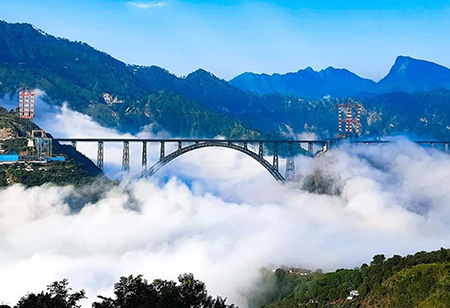
Chenab Bridge: Elements that will Bridge Kashmir's Rail Connect with India


Possibly the largest civil engineering challenge ever encountered by a railroad project in India's recent history is the Chenab bridge. Between Bakkal and Kauri in the Reasi district of Jammu & Kashmir, a concrete arch bridge was built. The project, which is a component of the USBRL (Udhampur-Srinagar-Baramulla rail link project), intends to improve connectivity in Jammu and Kashmir.
Much taller than the Eiffel Tower, the 1.315 km long bridge is being constructed at a breathtaking height of 359 meters. It will link the powerful River Chenab in the Reasi district with the Salal-A and Dugga railway stations on either side of the bridge. A golden joint will be used to commemorate the occasion, which is seen as a sign of national unity.
Features
This railroad bridge, known as Chenab Bridge, will span the Chenab River at a height of 1315 meters, 359 meters above sea level. With a height of 275 meters above sea level, the tallest railway bridge in existence at the time is situated on the Bepanjiang River in Guizhou Province, China. The 111 km long Katra-Banhal railway line, for which enormous Himalayan Hills are being mined, will now be completed, which is a significant accomplishment.
With a 5.6-meter span at the top of the bridge connecting at the center on both sides, installing the arch before building the deck was one of the toughest civil engineering difficulties in recent Indian history. 111 kilometers. More than 85 percent of the 97 kilometers of tunneling is underground. No other region in the nation has experienced tunneling on this scale. Thus far, 86 kilometers of tunneling work have been finished. The bridge's arch, which was built on Darya Chenab, can resist winds of up to 266 kph.
The bridge is 1315 meters long. There are 17 pillars, and it cost an estimated Rs. 1,486 crore to build with 28660 metric tons of steel. 10,619 metric tons is the weight of the installed arch. The structure's steel can withstand temperatures as low as minus 40 degrees Celsius. The bridge will be made for trains traveling at a speed of 100 km and will have a minimum lifespan of 120 years.
This bridge has the capacity to endure blast loads, 266 kilometer per hour winds, and powerful earthquakes. Five of the 93 deck segments, each weighing around 85T, are currently under construction as the bridge's 93 parts being launched concurrently on reinforced steel arches from both ends. The upper deck of the bridge will eventually be finished by connecting the two ends using High Strength Fraction Grip (HSFG) bolts.
Following the removal of Article 370, the government announced numerous development projects and programs for the J&K region, giving the development of the territory's infrastructure a major boost.
Quality and Safety
As a result of the emphasis placed on quality and safety, a NABL laboratory was set up at the Afcons site to monitor quality at all stages, perform weld sample tests, etc., saving a significant amount of time. Additionally, NR approved the first use of a phased array ultrasonic testing machine in the nation for the purpose of inspecting welds.
The project's access roads helped create jobs locally and improve accessibility to a number of isolated settlements in the area. Fabrication work was done at workshops on both ends, with the heavy, bulky portions being delivered to the launch pad using a specialized modular trailer.
Challenges
The project had to cope with a number of difficulties, including slope stabilization, strong winds, severe weather, seismic activity, and potential terrorist attacks. As a result, the bridge had to be built to withstand wind speeds of 260 km/h, blast impact loads, and temperatures as low as -20 °C. To provide train regulation for wind speeds, earthquake activity, and strain gauging of crucial steel components, sophisticated train control and bridge monitoring are also necessary. The largest span cable crane in the world must be used for construction, which must be done using cable cars.
Technology
The success of this iconic project, one of the first in India to apply cutting-edge technology to traditional survey and construction work, will alter current workflows and inspire the use of contemporary technologies in projects of a similar nature around the world.
The organization used OpenRail Designer to meet the rigorous rail alignment demands, OpenBridge for bridge planning and analysis, and STAAD for structural behavior analysis of the massive bridge. ContextCapture was used for construction planning, monitoring, inspection, and surveying. The application was critical in managing the construction site progress and conducting inspection during construction to accelerate the project and ensure quality, repeatable documentation of the bridge inspection. ContextCapture helped save 225 days in surveying, equating to US$40,000 in savings, and reduced construction inspection time by 80 percent, resulting in savings of more than $100,000.
Need
The key to development is connectivity. Due to poor connectivity, primarily caused by challenging terrain, Kashmir was almost isolated from the rest of the country. It was preventing the area's overall development. While there was road transit, the trip was tiresome for the travelers. The rail link will enable 24 hour access to and from the valley thanks to Indian Railways. This affordable mode of transportation would bring in new growth in the area by making it easier to carry all local goods across India, particularly apples and handicrafts made of warm clothing and wood.
The region's agriculture and horticulture sectors have previously expressed concern about the region's underdeveloped key roadways since the transit of fruits required a disproportionately long time to reach market destinations. Yet as the government pursues the development of key motorways on a priority basis, that dread is gradually giving way to hope. These connectivity initiatives are anticipated to lead to commercial and job prospects for Kashmiri youth, as well as development and prosperity in the region.